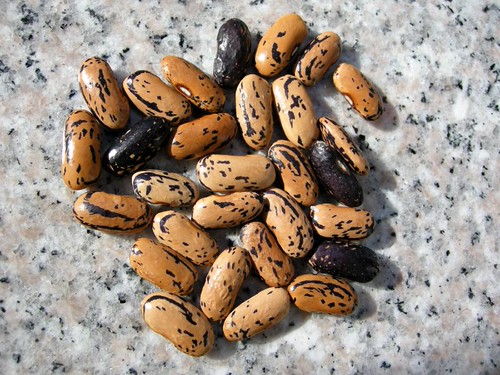At the seed meeting there was a major seed exchange on the first evening (and during breaks the following days) I would like to introduce some of my new friends.
‘Biskopens gråært’ is one of the rare solid purple seeded pea varieties. It is a greypea, the oldfashioned fieldpea being a stable food in northern Europe in very old times. Now with famine well at distance the deserve a revival. I hope a famous chef will take courage to dicover it and serve it in modern ways. We have saved a treasure of these old peas.
This particular greypea is a swedish heirloom, passed on by SESAM, the swedish seed savers.
The pea ‘Goroh’ is an old russian heirloom from Kalmutskaya region in Russia. It has white flowers and rather small round green seeds, drying yellow. Originally from Dr. Tatiana Veronina (Moscow), via Seed Savers Exchange and a norwegian seed saver to Denmark. It can be eaten both as a snowpea and as a delicious and quickly boiling soup pea.
This wax pole bean has long broad yellow pods, and is an early romano-type. It’s an heirloom from the Bacau in northern Romania, passing Seed Savers Exchange on its route to Denmark. It’s said to have a gorgous taste, I look forward to the season.

Russian bush drybean ‘Bean 04-2006’
UPDATE february 2011 – I had a look in the original seedsamples, and noticed, that this and the following photo had been misplaced, now they show the correct cultivar.

Russian bush drybean ‘Bean 05-2006’
These two russian heirlooms Frøsamlerne has got from Lothar Juffa in East Friesland, Germany. They originates from volga-german families, settled near Omsk in Sibiria. Zarina Katharina the Great called in a lot of german peasants to settle on land she gave them on the Volga river. Later Staling executed a lot of them and resettled the rest in Sibiria, where they have lived since.
Both are early and prolific drybeans, the latter a bit earlier and slightly taller. I’m about to develop a weakness for these Volga-german varieties, as I have only good experiences with them – they have stand the test of time and hardship.



May 2, 2008 at 11:18
I’m really looking forward to seeing how all of these come out.
April 26, 2009 at 00:10
If you should have some spare seed of ‘Biskopens gråært’ I would like to organise a swap.
Let me know if your interested, all the best.
Graham.
April 4, 2012 at 22:16
Hi Soren,
You have a fascinating blog with beautiful photographs. I work with legume root membranes and am very interested in peas of different types. I can offer soybeans in exchange, or Indian “native type” quite sour tomatoes [they are liked for their sourness; indeed, some, modern Indian hybrids are bred to emulate the so-called “native” or country type tomatoes with sour taste and wild tomato aroma!]. Whenever you have Lollandske Rosiner, and Biskopen Graert seeds to spare, I should be grateful to swap 5-6 seeds each with you, if that is feasible? I am very interested in the fact that LR has evolved to grow in cold, heavy soils. Please let me know of any other peas that have adapted to other unusual soil conditions.
Thanking you,
Warm regards,
Gautam.
New York, USA.
April 5, 2012 at 22:14
Gautam, I’ll send you an email 🙂
October 22, 2012 at 05:43
[…] hopefully enough to maintain some genetic diversity. The only other sources for this pea are a few hardcore enthusiasts and a seed bank in […]
December 31, 2013 at 06:22
[…] also managed a decent crop of our exceedingly rare Bishop’s Grey peas, originally brought to us by way of Bosnia. It took a little research to discover that they are […]